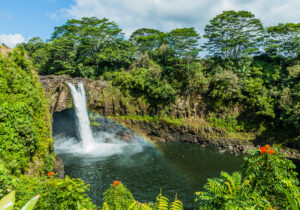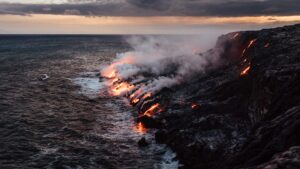John Derrick for Hawaiʻi-Guide.com on the Hawaiʻi Volcanoes National Park which is one of the major attractions on our volcano tours.
Originally founded in 1916, Hawaiʻi Volcanoes National Park (HVNP) is a living, breathing testament to the awesome power of Mother Nature. HVNP is located 30 miles southwest of Hilo and 96 miles southeast of Kona. It’s open year-round, 24 hours a day.
HVNP is home to Kilauea Volcano, the most continuously active volcano in the world, and the park offers the unique experience of walking on land that is younger than you are. Visitors are also witness to the world’s largest volcano Mauna Loa at 13,677 feet. Mauna Loa, meaning ‘long mountain,’ encompasses a huge chunk of the Big Island. In recognition of its outstanding natural values, Hawai’i Volcanoes National Park has been honored as an International Biosphere Reserve and a World Heritage Site.
The park encompasses 333,000 acres of natural wonders and is situated at 4,000 feet above sea level. With its wealth of trails, drives, and activities you will need at least two days to fully experience all the park has to offer.
There have been several big changes lately at Kilauea volcano – especially at and within Kilauea Caldera, Halemaumau Crater, Pu’u O’o vent, and along the east rift zone. New (geologically speaking) seismic and visible activity started at Kilauea caldera within Halemaumau in mid-June 2007, and ongoing events between 2007-2008 necessitated several area closures within the park. A lava lake would eventually become visible at the summit within Halemaumau Crater. Beginning April 30, 2018, at the summit when the crater floor collapsed, and into early May 2018, another set of seismic events caused the lava lake to drain from the summit of Kilauea, and a new eruption subsequently began within the eastern rift zone (within Puna district). This eruption, which mostly occurred from ‘Fissure 8,’ in the Leilani Estates subdivision, continued until early August 2018, at which point the eruption had nearly subsided. On December 5, 2018 – the eruption was declared officially ended. On December 20, 2020, at approximately 9:30 pm HST the USGS Hawaiʻian Volcano Observatory detected a new glow within Halemaumau crater
at the summit of Kilauea Volcano. This eruption continued until May 2021. On September 29, 2021, at3:20 pm HST, a new eruption has now commenced at Kilauea’s summit caldera.
Ongoing Eruption Updates
This situation often rapidly evolving and the Hawaiʻi Volcanoes Observatory will continue to issue statements when more information is available to the public. For now, you can receive ongoing eruption updates by following the social media accounts of the Hawaiʻi Volcanoes National Park (Facebook, Instagram, and Twitter). You can also view the live cameras located at the Kilauea summit.
You can also always check our Where is the Lava Located page to read more about recent lava flows, including updates on the current eruption.
We encourage visitors to check the National Park Service Kilauea Volcano Activity page or the USGS Volcano Update page before visiting the park.
Operating Hours
Hawai’i Volcanoes National Park is open 24 hours a day year-round. Kilauea Visitor Center is open daily from 9:00 a.m. to 5:00 p.m. Hours are subject to change; find the current hours at the national park website.




